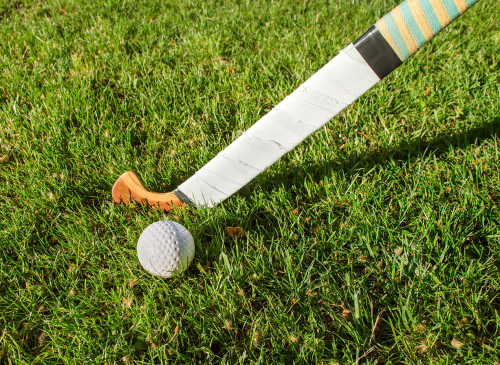Who's the Winner?
When two closely matched teams play each other, what is the most likely result?
Problem
Who's the Winner? printable sheet

When the teachers play the students at hockey, they are equally matched - at any point in the match, either team is equally likely to score.
What are the possible results if 2 goals are scored in total?
Why are they not all equally likely?
This mathematical model assumes that when a goal is scored, the probabilities do not change. Is this a reasonable assumption?
Alison suggests that after a team scores, they are then twice as likely to score the next goal as well, because they are feeling more confident. What are the probabilities of each result according to Alison's model?
Charlie thinks that after a team scores, the opposing team are twice as likely to score the next goal, because they start trying harder. What are the probabilities of each result according to Charlie's model?
The models could apply to any team sport where a small number of goals are typically scored.
You could find some data for matches between closely matched teams that finished with two goals and see which model fits most closely to what happened.
You will need to make some assumptions about what it means for teams to be "closely matched".
Send us your conclusions, and explain the reasoning behind the assumptions you chose to make.
Getting Started
You could simulate the goal scoring using dice - an odd number could represent a goal for the teachers and an even number could represent a goal for the students.
Simulate a few games where two goals are scored and record how many "wins", "draws" and "losses" occur.
Student Solutions
Thank you to Anna from Mt Eliza North Primary School, Australia, who sent us this solution:
1. What are the possible results if 2 goals are scored in total?
2-0, 0-2, 1-1.
2. Why are they not all equally likely?
They are not all equally likely because there are two ways you can get the end result, 1-1, by the teachers scoring first and then the students or the students scoring first and then the teachers. There is one way for the end result, 2-0, the teachers get the 2 goals without the students getting 1. And there is only one way you can get the end result 0-2, by the students getting both the goals. Therefore the end result 1-1 is more likely.
3. Is this a reasonable assumption?
Yes. Even if the teachers are more confident and the students are trying harder, those equal out so the chance would stay at 50-50.
4. What are the probabilities of each result according to Alison's model?
In Alison's model the team who scores first is twice as likely to score the next goal.
The chance of ending 2-0, with the teachers winning, is:
$\frac{1}{2}$$\times$$\frac{2}{3}$$=$$\frac{1}{3}$
so there would be a 33.3% chance of that occurring.
The chance of ending 2-0, with the students winning, is also 33.3%:
$\frac{1}{2}$$\times$$\frac{2}{3}$$=$$\frac{1}{3}$
The chance of ending 1-1, with the teachers scoring the first goal and the students scoring the second goal, is:
$\frac{1}{2}$$\times$$\frac{1}{3}$$=$$\frac{1}{6}$
The chance of ending 1-1, with the students scoring the first goal and the teachers scoring the second goal, is also:
$\frac{1}{2}$$\times$$\frac{1}{3}$$=$$\frac{1}{6}$
So altogether the chance of ending 1-1 is also 33.3%:
$\frac{1}{6}$+$\frac{1}{6}$=$\frac{1}{3}$
Therefore, using Alison's model there is a 33.3% chance of any of the three results occurring.
5. What are the probabilities of each result according to Charlie's model?
In Charlie's model, after a team scores, the opposing team are twice as likely to score the next goal, because they start trying harder.
The chance of ending 2-0, with the teachers winning, is:
$\frac{1}{2}$$\times$$\frac{1}{3}$$=$$\frac{1}{6}$
so there would be a 16.7% chance of that occurring.
The chance of ending 2-0, with the teachers winning, is also 16.7%:
$\frac{1}{2}$$\times$$\frac{1}{3}$$=$$\frac{1}{6}$
The chance of ending 1-1, with the teachers scoring the first goal and the students scoring the second goal, is:
$\frac{1}{2}$$\times$$\frac{2}{3}$$=$$\frac{1}{3}$
The chance of ending 1-1, with the students scoring the first goal and the teachers scoring the second goal, is also:
$\frac{1}{2}$$\times$$\frac{2}{3}$$=$$\frac{1}{3}$
So altogether the chance of ending 1-1 is 66.6%:
$\frac{1}{3}$+$\frac{1}{3}$=$\frac{2}{3}$
Therefore, using Charlie's model there is a much greater chance of ending up with a 1-1 result.
Krystof from Uhelny Trh, Prague, used tree diagrams to work out the probabilities.
Teachers' Resources
Why do this problem?
This problem offers the opportunity to use probability in an authentic sporting context. It introduces the idea of using a probability model to make predictions, and then to refine the model using real data.
Possible approach
Introduce the idea of two equally matched teams (teams who are equally likely to score the next goal).
Key questions
Why are the results "win", "draw" and "lose" not all equally likely?
Possible support
Ask pairs of students to simulate the different models using dice, and collect together all the results. Then introduce tree diagrams to explain the results of the simulation.
Possible extension
Students could find data (perhaps from school or local teams) and decide on criteria for identifying "closely matched" teams. Then matches between closely matched teams where exactly two goals were scored can be analysed to see which model best fits the data.
